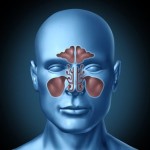 About 34 million Americans suffer with sinus problems. Often a cold will plug up the ostea, preventing the sinuses from draining properly. The moist, warm, mucus-packed sinus becomes a breeding ground for bacteria. To the patient, it seems to be a cold that just doesn’t go away. Chronic sinusitis produces pressure between the eyes, on the sides of the nose, or in the front of the forehead. There is a stuffy feeling, and the victim frequently has headaches. He or she often has a runny nose, sore throat, and/or a cough from the constant draining of mucus.
About 34 million Americans suffer with sinus problems. Often a cold will plug up the ostea, preventing the sinuses from draining properly. The moist, warm, mucus-packed sinus becomes a breeding ground for bacteria. To the patient, it seems to be a cold that just doesn’t go away. Chronic sinusitis produces pressure between the eyes, on the sides of the nose, or in the front of the forehead. There is a stuffy feeling, and the victim frequently has headaches. He or she often has a runny nose, sore throat, and/or a cough from the constant draining of mucus.
One thing that may tip you off to the possibility that your patient has a sinus problem is that he or she will have several “colds” in a row. The patient may tell you that they get sick a lot. What they are experiencing is a single infection that never really clears up. Another sign is a “tickle” in the back of the throat that causes a non-productive cough.
Because of the repeat bouts of infection the patient may take antibiotics on a regular basis. This can create digestive problems or immune system problems. Repeated courses of antibiotic therapy can create dysbiosis (overgrowth of yeast or other pathologic microorganism in the intestine) and ultimately lead to other problems like headaches, fatigue, digestive problems and allergies. A study published in the journal Pediatrics (April 2001;107:619-625) also found that antibiotic therapy did no better than the placebo in preventing the recurrence of sinus symptoms.
Research published in Archives of Internal Medicine (2003;163:1832-1836.) and performed by scientists at Georgetown University Medical Center, shows a link between fatigue, unexplained pain and chronic sinusitis. More than 20% of the subjects in the study met the criteria for a diagnosis of chronic fatigue syndrome. Most of the chronic fatigue syndrome patients had sinus symptoms. Many noted a sudden onset of their illness, something they have in common with patients suffering with sinusitis.




